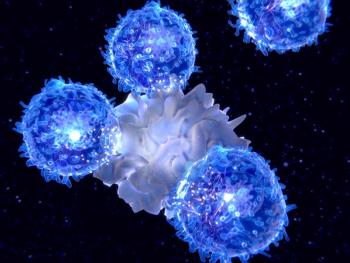
Oncology NEWS International
- Oncology NEWS International Vol 10 No 3
- Volume 10
- Issue 3
Hodgkin's Disease on the Increase in Patients With HIV
SAN FRANCISCO-An Italian study has found that Hodgkin’s disease is becoming more frequent than non-Hodgkin’s lymphoma (NHL) in people with HIV. The researchers speculate that this rise in Hodgkin’s disease may be due to the advent of highly active antiretro-viral therapy (HAART). Alessandro Re, MD, of the Universita di Brescia, presented the results at the American Society of Hematology annual meeting.
SAN FRANCISCOAn Italian study has found that Hodgkin’s disease is becoming more frequent than non-Hodgkin’s lymphoma (NHL) in people with HIV. The researchers speculate that this rise in Hodgkin’s disease may be due to the advent of highly active antiretro-viral therapy (HAART). Alessandro Re, MD, of the Universita di Brescia, presented the results at the American Society of Hematology annual meeting.
According to Dr. Re, the recent introduction of HAART has changed the natural history of HIV infection, and may also have influenced the development and outcome of HIV-related lymphomas. While the incidence of primary cerebral lymphoma has clearly decreased, he said, changes in the frequency of other lymphomas are less well documented.
Dr. Re and his team therefore analyzed the incidence of HIV-related lymphomas diagnosed at their institution before and after the introduction of HAART in 1997. Their analysis covered 5,699 consecutive and unselected HIV-positive patients, prospectively followed from the onset of the HIV epidemic in 1985 to the present.
A total of 103 patients developed systemic aggressive NHL over the 15 years surveyed, while 22 developed Hodgkin’s disease.The mean number of new HIV patients registered per year did not change over time (380 pre- vs 326 post-HAART); nor did the overall number of new HIV-related lymphomas per year (7.9 pre- vs 9 post-HAART).
However, the annual number of systemic NHL cases slightly decreased, from a mean of 6.9 pre-HAART to 5.5 post-HAART (P = .6), while the annual number of Hodgkin’s disease cases significantly increased, from 1.0 pre-HAART to 3.5 post-HAART (P = .02).
The median CD4 count at diagnosis was higher after the use of HAART, both in Hodgkin’s disease (119/mL3 pre- vs 210/mL3 post-HAART) and NHL (59/mL3 pre- vs 166/mL3 post-HAART).
Dr. Re reported that, within the limits of this small study, there were no significant differences between the pre- and post-HAART eras in patient demographics (number of drug abusers, number with prior AIDS) or in the clinicopathologic features of Hodgkin’s disease (disease stage, B symptoms, extranodal disease, histology). Similarly, there have been no significant changes in these parameters in patients developing NHL since the advent of HAART.
Dr. Re speculated that the reconstitution of the immune system due to HAART may favor "the development of lymphomas with a rich lymphoid reactive compartment."
Articles in this issue
over 24 years ago
First Racial-Ethnic Breast and Cervical Cancer Screening Dataover 24 years ago
Mitotic Activity Index IDs High-Risk Node-Negative Breast Cancerover 24 years ago
Disclosure Issues in Cancer Gene Testing Worry Doctorsover 24 years ago
Functional Assessment of Geriatric Cancer Patients Neededover 24 years ago
Mobile Mammography Programs Are Struggling to Surviveover 24 years ago
Ellence Research Fund Names 11 Grant Recipientsover 24 years ago
Hyperfractionated RT Ups Pharynx Cancer Survivalover 24 years ago
Internet Creates Virtual Radiology DepartmentNewsletter
Stay up to date on recent advances in the multidisciplinary approach to cancer.

















































































